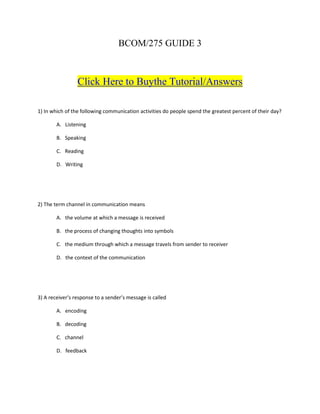Bcom 275 guide 3 5) With this type of response, you analyze or teach the sender about the cause of his or her concern. A. Evaluating B. Interpreting C. Questioning D. Paraphrasing
- 1. BCOM/275 GUIDE 3 Click Here to Buythe Tutorial/Answers 1) In which of the following communication activities do people spend the greatest percent of their day? A. Listening B. Speaking C. Reading D. Writing 2) The term channel in communication means A. the volume at which a message is received B. the process of changing thoughts into symbols C. the medium through which a message travels from sender to receiver D. the context of the communication 3) A receiver¡¯s response to a sender¡¯s message is called A. encoding B. decoding C. channel D. feedback
- 2. 4) This response style normally does not help unless the sender has asked for your advice. A. Paraphrasing B. Evaluating C. Questioning D. Interpreting 5) With this type of response, you analyze or teach the sender about the cause of his or her concern. A. Evaluating B. Interpreting C. Questioning D. Paraphrasing 6) This act is involuntary and happens automatically. A. Responding B. Feedback C. Listening D. Hearing 7) Which of the following is a category of reasonless advertising? A. Logical ads B. Promise ads C. Endorsement ads D. Functional ads
- 3. 8) Which of the following are the most common types of doubts people may have about a source? A. Status and academic degree B. Occupation and employer C. Expertise and accuracy D. Prominence in the field of study and experience 9) A claim is generally not considered credible if A. it seems likely B. the claimant is an interested party C. it comes from a source assumed to be credible but who is not known to you D. the claimant is a disinterested party 10) Providing only two choices when others are available defines which fallacy? A. Ad hominem B. False dilemma C. Genetic fallacy D. Straw man 11) Stating someone has negative features and his claim is invalid is an example of which fallacy? A. Ad hominem B. False dilemma C. Genetic fallacy
- 4. D. Straw man 12) Consider the following statement: ¡°So what if the Senator accepted a little kickback money¡ªmost politicians are corrupt after all.¡± This is an example of which fallacy? A. Argument from envy B. Straw man C. Argument from tradition D. Argument from common practice 13) Measurable or observable characteristics of your audience are called A. pseudographics B. statistics C. psychographics D. demographics 14) Behavior descriptions should meet which of the following criteria? A. Present inferences about another¡¯s motives. B. Focus on more than one behavior. C. Describe only observable behaviors. D. Include terms such as ¡°never, always, or constantly.¡± 15) Demographics include which of the following? A. Ethnicity, gender, race B. Beliefs, feelings, likes C. Attitudes, interests, values
- 5. D. Values, morals, opinions 16) You want to discuss your performance review and possible raise with your boss. The most effective channel to do this would be A. face-to-face B. text message C. e-mail D. team meeting 17) Sound and light waves are an example of which part of the communication model? A. Noise B. Channel C. Encoding D. Decoding 18) Which informal communication channel involves its own abbreviations to accommodate the limited number of characters available in any given message? A. E-mail B. Voicemail message C. Text message D. Handwritten letters 19) When are nonverbal messages sent? A. Before verbal messages B. Only in combination with verbal messages C. Only when you want
- 6. D. After verbal messages 20) Which verbal support breaks down complex processes or concepts into their component parts to ensure understanding? A. Descriptions B. Analyses C. Comparisons D. Definitions 21) When using expert testimonials, speakers should do which of the following? A. Share the expert¡¯s credentials. B. Protect the identity of experts by not naming them. C. Always quote the expert¡¯s exact words. D. Use experts who have celebrity status. 22) When you use an expression like raining cats and dogs, you are using A. denotative language B. connotative language C. figurative language D. contextual language 23) Persuasive topics that attempt to show an audience that something is good, bad, right, or wrong are topics of
- 7. A. value B. policy C. cause-effect D. fact 24) The connotation of words such as skinny or thin focuses on the A. emotional meaning B. denotative meaning C. actual meaning D. contextual meaning 25) What logical fallacy can occur when a speaker focuses on similarities and ignores significant differences? A. Faulty comparison B. Slippery slope C. Either/or thinking D. Hasty generalization 26) If you use only a few examples to represent the whole of the conclusion, you are committing this logical fallacy. A. Faulty causation B. Hasty generalization C. Either/or thinking
- 8. D. Slippery slope 27) When you display ethos in your persuasive presentation, you have A. evidence B. credibility C. logic D. emotion 28) Deliberately blaming individuals or groups for things they really did not do is called A. stereotyping B. ethnocentrism C. scapegoating D. discriminating 29) A concept proposing that negative cultural assumptions about a group can create for its members a belief in those assumptions is called A. a halo effect B. an attribution error C. a stereotype threat D. a perceptual process 30) Groups that value higher power distance believe relationships are A. hierarchical B. individualist
- 9. C. relationship oriented D. informal 31) Utilitarianism is part of this perspective on moral reasoning. A. Consquentialism B. Deontology C. Moral relativism D. Virtue ethics 32) What is the belief that correct moral principles are those accepted by the correct religion known as? A. Virtue ethics B. Religious absolutism C. Religious relativism D. Moral relativism 33) The practice of using a case that has already been decided as a guide when deciding new cases is referred to as A. legal paternalism B. legal morality C. causation principle D. appeal to precedent








